Walker & Berg: Updates on Wordless Novelists
INTRODUCTION
Much has happened since I first wrote about a pair of Canadian artists who have created exemplary wordless novels in relief prints. George Walker first appeared in ART I SEE on Jan. 9, 2015 with: http://www.scottponemone.com/george-walker-wordless-novelist/. My interview with him led me to Stefan Berg, a generation younger than George. My post on Stefan appeared on April 17 with: http://www.scottponemone.com/stefan-berg-buddy-bolden-in-black-white/ I had the pleasure to meet both artist this past June in Toronto, their hometown, and I wrote about this experience in this fall’s Newsletter for the Print, Drawing & Photograph Society (PDPS) of the Baltimore Museum of Art.
First I’d like to reprint the Newsletter article with additional images and then give readers updates on each artist. For George Walker this will mean the publication of his fifth wordless novel, Trudeau: La Vie en Rose. For Stefan Berg this will mean great progress on his second wordless novel based on the life of Glenn Gould.
I also would like to announce that George Walker will visit Baltimore in November first to meet with Maryland Institute College of Art classes and then to talk to PDPS members about wordless novels. (Members will have an opportunity to sign up in early November to attend his talk.)
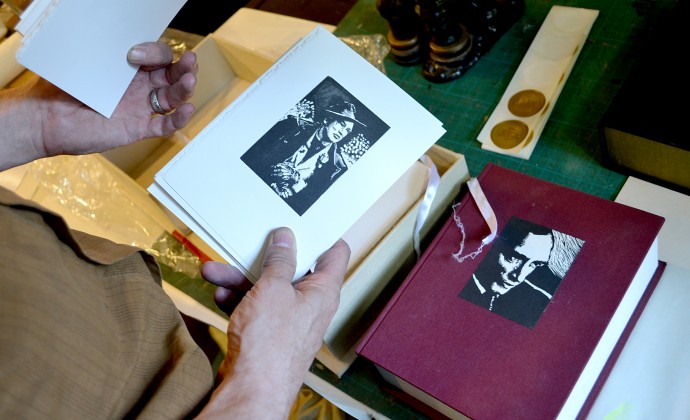 George Walker examines proof impressions for his wordless biography on former Canadian Prime Minister Pierre Elliott Trudeau. (All photos in this reprint are by Scott Ponemone.)
George Walker examines proof impressions for his wordless biography on former Canadian Prime Minister Pierre Elliott Trudeau. (All photos in this reprint are by Scott Ponemone.)
George & Stefan: Wordless Novelists in Toronto
Two hours after driving into Toronto last June, I’m sitting at a picnic table on the terrace outside an Irish pub. Laughter and beer all around. Across from me is George Walker. To his right is Stefan Berg. To George’s left is Justin Labine, who has just given me a woodcut of a skull in profile. To my left is my spouse Michael Frommeyer. To my right is George’s wife Michelle.
Michael and I had made arrangements to interrupt our Montreal vacation to drive to see George and Michelle. And when they told us that they had invited Stefan to join us for dinner, I was totally delighted. Let me explain why.
Because both George and Stefan have authored wordless novels in relief prints, I initially emailed them in pursuit of owning their books. I first purchased a hardback trade edition of George’s Book of Hours (The Porcupine’s Quill; Erin, Ontario, 2010) before I asked him questions that led to a Jan. 9, 2015, post in my ART I SEE blog: George Walker: Wordless Novelist. His book lovingly and magically imagines the last 24 hours in the lives of workers at the World Trade Center.
He in turn alerted me to the work of Stefan Berg, from whom I soon bought a suite of signed proofs from his book Let That Bad Air Out: Buddy Bolden’s Last Parade (The Porcupine’s Quill; Erin, Ontario; 2007). This contact led to an April 17 blog post: Stefan Berg: Buddy Bolden in Black & White. Stefan’s book takes you back to 1906 New Orleans for the last parade led by legendary cornet player Buddy Bolden.
< George Walker
In the flood of today’s graphic novels that usually rely on word balloons and computer-enhanced images, the work of George and Stefan rise like islands of printmaking tradition. By solely using wood engravings—as George does—or linoleum cuts—as Stefan does—they carry the flag of important 20th-century wordless novelists, notably Frans Masereel in Belgium, Lynd Ward and Giacomo Patri of the U.S., and Laurence Hyde of Canada.
Yet there’s another connection between George and Stefan besides being Canadian and wordless novelists. George Walker is an associate professor at Toronto’s OCAD University (formerly the Ontario College of Art) in the book arts program. He was a well-known illustrator when Stefan Berg, 20, approached him for guidance in producing his Buddy Bolden book. Not only did George mentor Stefan but helped get Stefan’s book published at The Porcupine’s Quill, where George served as artistic director.
Oddly enough, George’s first hand-printed wordless novel—Book of Hours—was published in 2008, a year after Stefan’s book came out.
By the time I arrived in Toronto in June, George was well underway with his fifth wordless novel, this time a biography of Pierre Elliott Trudeau (1919-2000). (His other wordless books were on painter Tom Thomson in 2011, media baron Conrad Black in 2013, and poet/songwriter Leonard Cohen in 2014.) Stefan, on the other hand, was beginning his second wordless novel after a lengthy period devoted to painting. His new venture is on legendary classical pianist Glenn Gould (1932-1982).
The next day after breakfast of Tango eggs (an omelet tucked into a croissant) at a nearby coffeehouse, George briefly showed me his studio, a converted one-car garage in the back of his modest duplex home. Every inch inside serves a purpose. His Vandercook proofing press hugs the wall to the left. His finished books fill shelves to the right. Past those shelves is his work table. Dozens of wood engraving tools lie in four well-organized rows in his tool box. His bookbinding press sits on a table at the far end of this small room. And everywhere else seems to hold bins of completed maple blocks from three decades of wood engraving. I’ll get to a more in-depth look later that day.
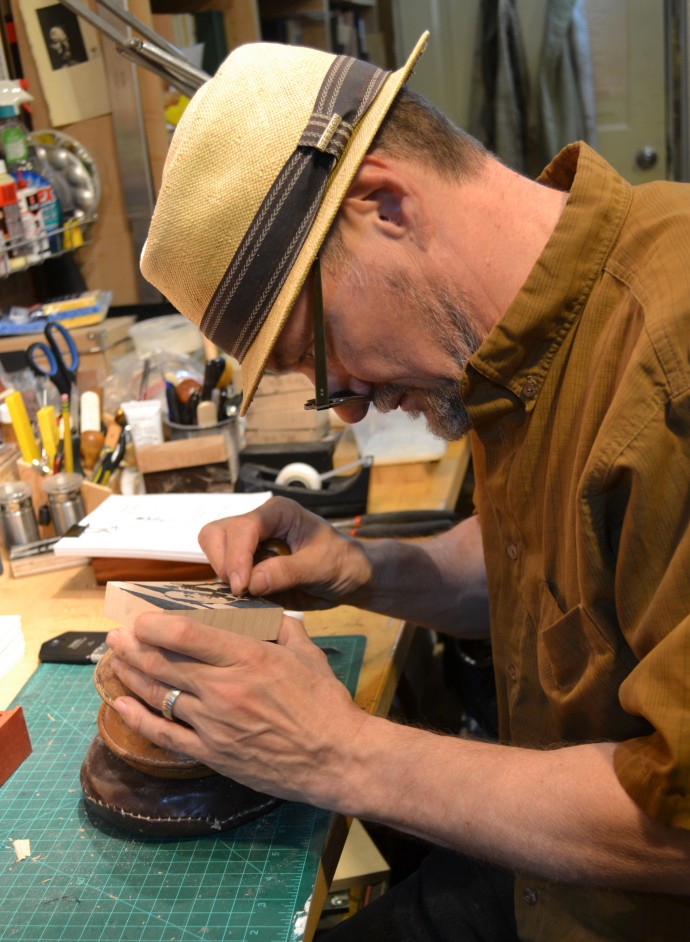 George engraves a maple block for his Trudeau book.
George engraves a maple block for his Trudeau book.
While George has some business matters to attend to, Michelle gets us into a members’ preview of the Picturing the Americas exhibition at the Art Gallery of Ontario. I’m tickled to see a Thomas Cole painting because I instantly recognize the view from Cole’s Catskill, NY, homestead, which we visited on our drive north to Montreal. We then meet George at OCAD, where he shows us the printmaking and books art facilities—very impressive.
Before dinner at a Lebanese restaurant with shared mezzes, I get another look at George’s studio. He opens a box with proofs of all of his Trudeau book images, and we discuss his fifth wordless novel project.
(I don’t take notes or do a video of our talk, but George agrees to answer emailed questions after my return to Baltimore. The quotes that follow are from his responses.)
When asked if he sought permission from the Trudeau family, George says, “Michelle and I flew to Ottawa to meet with P.E.T.’s ex-wife Margaret Trudeau and … presented her with some preliminary proofs of the images.”
Why Trudeau, I ask. George says, “I was attracted to the turmoil and energy that surrounded the Trudeau era from 1968 till the 1980s. … These were my coming-of-age years, and I wanted to create a narrative that reflected how the life and times of Trudeau defined and shaped the Canadian consciousness.”
And will your book be chronological? “It is a chronological biography, but I am pursuing something else too. It’s that certain thing the French describe as ‘je ne sais quoi.’ It’s ineffable, and that is why the wordless narrative works for such a project. How does one capture the feeling of a time or the mood of an era?”
I ask him to take me through the production sequence.
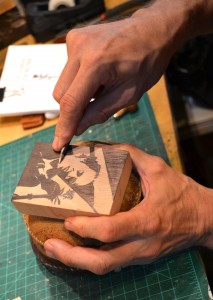 • “The first step is always research. It’s not just picture research; it also involves reading books and articles about the subject. The early collection of data helps me when constructing a storyboard and deciding on the sequence and symbols I will use.
• “The first step is always research. It’s not just picture research; it also involves reading books and articles about the subject. The early collection of data helps me when constructing a storyboard and deciding on the sequence and symbols I will use.
• “Next I prepare the blocks I am going to engrave. If I am making the blocks myself—then I must order the wood and set aside a few days of cutting type-high blocks.
• “Then I draw on the finished polished blocks. I usually draw and ink-in (reversed so when they print they are right way around) about ten blocks before I start engraving. I like to engrave with the same tool on several blocks and then switch tools and start the pile again.
• “Once I have ten blocks ready, I ink up the press and begin to proof. If I like the proof, then I’m done (I rarely like the first proof)—but it’s more likely that I engrave some more on the block until I get the image to a point I am happy with.
• “These proofs are then piled in a special clamshell box I have made. I then have a pile of printed cards which I can shuffle and reorder till I get a narrative that I am happy with. I created over 100 engravings for the Trudeau project of which I am using only 80. Trudeau was 80 years old when he passed away on September 28, 2000 in Montreal.”
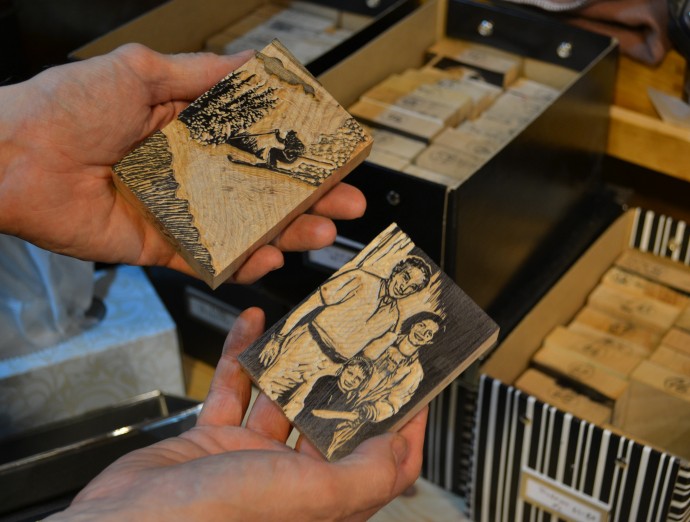 George holds up two wood engraved blocks for his Trudeau book. The boxes in the background hold other finished blocks.
George holds up two wood engraved blocks for his Trudeau book. The boxes in the background hold other finished blocks.
George says his next step is to seek writer(s) for the book’s intro. He plans to write a chronology and a preface for his Trudeau book. His next step is to design the text pages, which he says can take a few months.
“When I am finally ready for the press,” George says, “I make a dummy book so I can work out the imposition of the pages for printing on the press. I use the dummy layout as a guide to what I have printed and what needs to be printed. That’s where I am right now [July 1] with the Trudeau project. I will be printing the pages from now until the beginning of August.
“The next steps are keeping the finished pages organized and then the folding and preparing the sheets for collation. Once I have all the text-blocks collated and sorted, they are ready for bookbinding. I then take a proof copy and try a number of experiments with the binding until I get it right.”
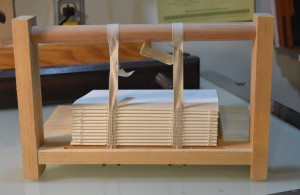 < George assembles his limited editions using a sewing frame.
< George assembles his limited editions using a sewing frame.
George aims to have the finished books in his hands by October—a year’s work. Giving strong credence to the significance of numbers, he says, “The book will be limited to 15 regular edition numbered copies and a further 10 special copies for participants. Trudeau was the 15th prime minister of Canada and was at the top of the CBC’s (Canadian Broadcast Corporation) Top 10 Canadian heroes list compiled from 12,000 Canadians who completed an online survey in 2014.”
Eventually we come to the negotiations. I really would like one of George Walker’s hand-printed books, if for no other reason than they have such a physical presence. The silk-covered boxes holding the Leonard Cohen book are 8.5” x 6.75” x nearly 3”. I jokingly refer to them as George’s bricks. The images are printed on Folio Rising Stonehenge 250 gm. paper. His impressions are strong. He encourages me to run a finger over an image so I can feel the relief.
Of his completed wordless novels, I would really like a hand-printed Book of Hours, but there were only 20 hand-printed in two versions. So I don’t ask. But I do like the Cohen book and agree to buy one. Then just before we head out to dinner, George announces that he thinks there’s a copy available of Book of Hours on delicate Yuki Gampi paper, one of eleven—the same edition that the Morgan Library & Museum owns. He says Michelle knows where it is. She’ll find it after dinner.
And so she does. It comes in a pale wooden box with a hinged wood stand nestled inside. The book itself is fragile and wonderful like a poem. Michelle is the keeper of prices, George declares. When she comes up with a figure, we negotiate briefly. I think everyone is pleased with the results. She promises by morning to have both packed in a small plastic hamper that housed some of her parents’ miniature doll parts … but that’s another story.
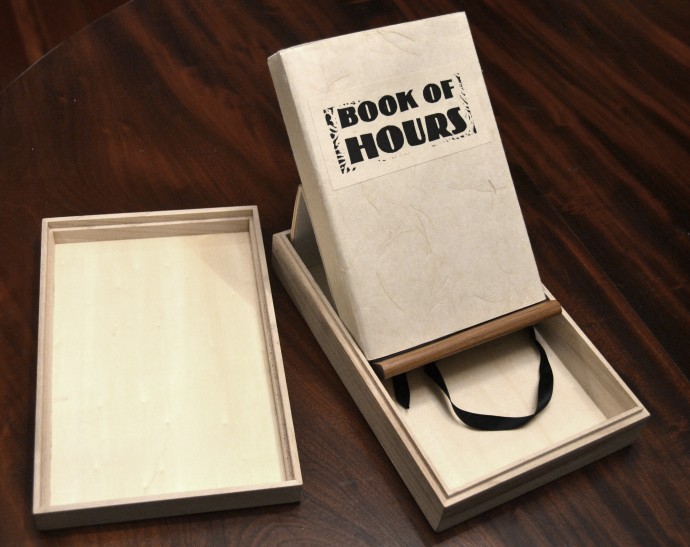 No. 8 of an edition of 11 comes in a wooden box and a hinged stand. (Below) Each image appears on the right side. The reversal of the previous page’s image is easily seen on the left.
No. 8 of an edition of 11 comes in a wooden box and a hinged stand. (Below) Each image appears on the right side. The reversal of the previous page’s image is easily seen on the left.
The next morning after picking up our precious cargo of Walker books, we drive a few miles to a short deadend street off a commercial strip. Stefan Berg’s studio sits atop an auto refinishing shop. He shows us a few drawings and linoleum blocks made in preparation for his Gould project. His hands are expressive as he describes the fundamental decisions that he needs to resolve—scale of image, for instance—before he starts to cut linoleum blocks for good. Stefan plans to produce most of the images during the summer while camped out at his family cottage, some 3 1/2 hours’ drive from Toronto.
(As with George Walker, the following quotes from Stefan’s responses to Q&A emails.)
Why choose to make Glenn Gould the subject of your second wordless novel? “I grew up a short distance from Gould’s childhood home,” Stefan says. “His recordings speak to my immediate surroundings. The music is present in my everyday as I walk the familiar streets, particularly in the cold when snow is falling. Gould’s idiosyncratic interpretations of classical scores, his focus on recording, splicing audio, and manipulating the mechanics of the piano are, as I see it, forms of early ‘collage’ music practice. I will create works which center around this idea, acting in dialogue with his own creative process, and reinterpret the public perception of him as an artist.
Stefan Berg holds a few of the preliminary drawings for his Gould project.
He then explains why working at the cottage is important. “The idea of the cottage itself is important, the act of self-reflection in solitude plays a large part in my narrative, as does place. I am working on this project at my cottage, simulating Gould’s own experience, his interaction with nature and the reflexive environment of isolation.”
At the dinner at an Irish pub as I watch his fingers work the table top, I realize that Stefan must have some keyboard ability. So I ask him about his interest in playing the piano. “You will think I’m crazy when I tell you this,” he says, “I do play, frequently, on four different pianos. Pianos float around Toronto. … However, my playing is unorthodox. I am not classically trained, and I compose music outside my capability for playing.”
Has he contacted the Gould family? “No, and I’m not sure if I will. I want to keep my Gould. I don’t want to know too much about the real Glenn Gould. We have our personal relationships to people we have never met, and this project is sort of about this, a personal kinship. My relationship with Gould is a construction of my own.”
Where are you on your project? “Early this spring—my first little retreat to the cottage alone—I listened to all of Gould’s recordings and interviews. I began compiling imagery, drawing out scenes from my mind, and storyboarding. Working out the visual aesthetic or style for my cutting process has been a lot of trial and error.”
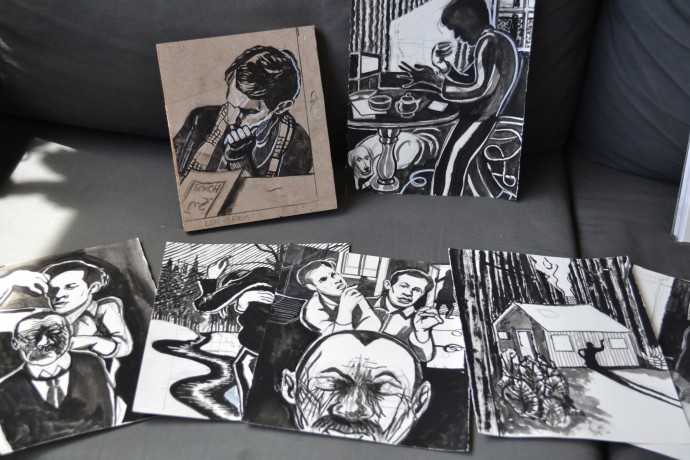 An array of sketches and a partially cut linoleum block for Stefans’ Gould book.
An array of sketches and a partially cut linoleum block for Stefans’ Gould book.
What decisions remain? “I am undecided whether to draw each image or just cut immediately into linoleum. I may draw each image rather large in charcoal. I like the push and pull of charcoal using the eraser as a drawing tool. I am contemplating the use of a laser cutter to do some of the cutting into the block. I will experiment with a tattoo gun to stipple the surface of the linoleum as well. The size of the block is undecided, and the orientation of the narrative is of course not something that will be complete until it’s literally bound. All this business I have been working on, waking up with conclusions to questions I go to bed with.”
How are you going to represent the music of Glenn Gould in static linoleum cuts? “The relationship between black and white, negative and positive, sound and silence, are initially how I thought of music being portrayed in a linoleum cut. … I will tackle the elements of tempo, cadence, pace, by altering the size and shape of each block and its orientation or sequence in the narrative. …”
< Stefan holds up two early linoleum blocks for his Gould book.
What will your Gould storyline be like? “The narrative is a series of vignettes; however, it takes place predominantly in and around the cottage environment. I would like to capture a feel for Gould’s playing and method of interpretation, to question possible perceptual influences as opposed to tell a story. The life and times of Glenn Gould has been done.”
What are your project deadlines? “I have three periods booked for working at my cottage this summer. I intend to finish my drawings by October and finish cutting by December. In terms of production, printing, and mass producing, I am undecided.”
Yet, unlike his Bolden book that only appeared in a paperback edition, Stefan knows his Gould project will be a “hand-printed portfolio; however, the scale and edition size is undetermined.”
So we left Toronto and drove back to Montreal, appreciating the difference experience plays in work routines of George Walker and Stefan Berg. George has established a discipline in creating his wordless novels without succumbing to rote procedure, while Stefan is returning to a medium in which he achieved acclaim as a young adult. After a few aborted efforts at wordless narratives, he’s committed to producing his second book, and it’s quite a daunting task he has set for himself. I look forward to discovering his results.
FALL 2015 UPDATES
Stefan Berg
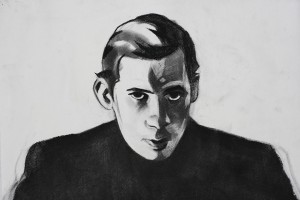 Stefan Berg was the first to respond for an update on 2 Oct. 2015. He also send along a number of photos to illustrate how far he’s come.
Stefan Berg was the first to respond for an update on 2 Oct. 2015. He also send along a number of photos to illustrate how far he’s come.
< Berg drawing of Gould.
How far along are you in your Gould project?
I have drawn about half of the images which currently make up my storyboard; however, I have also edited my storyboard and increased the total images in my story. My photographs are of drawings (charcoal on paper approx. 22″ x 30″ , pen and ink, and graphite) and a selection of blocks, ranging in different styles. Now I have a clear approach in mind for depicting my story stylistically. Through trial and error I have decided to discontinue drawing in charcoal, to draw with ink directly onto the block, and cut by hand as opposed to laser cutting. My deadline for December 31 remains ( the completion of my story, and the transfer of my images, and finalizing the orientation and scale of my blocks ) where upon I will carve and print my blocks in a short period following.
Has the project evolved in any ways you couldn’t have predicted? If so, in what ways?
I have focused more on Glenn Gould’s idiosyncratic interpretations of classical scores and his recording process, as oppose to the single event of Gould composing The Goldberg Variations. I have drawn a stronger relationship between sound and silence in black and white (negative and positive) by contemplating the significance place and solitude play within Gould’s creative process. Through an Access Copyright grant I was afforded more time to research Gould, using the CBC [Canadian Broadcast Corporation] catalogue of audio/visual documentation of Gould in performance and interview. My narrative now acts in dialogue with Gould’s creative process and reinterprets the public perception of him as an artist. The piano chair is one example of many Gould tropes used in my narrative. Throughout my research I have come to realize my own symbolism which defines Gould’s character and places the reader/viewer. My depictions of Gould in performance are (and will be ) created from motion picture to help capture the tempo and rhythm of the figure in motion and to lend an energy and resonance found in his particular style of performance.
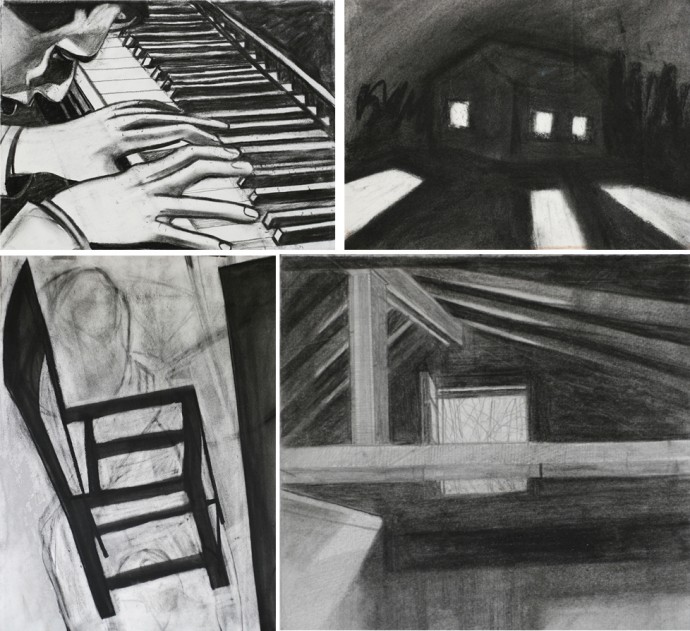 Sketches for Stefan’s Gould project.
Sketches for Stefan’s Gould project.
GEORGE WALKER
George Walker understandably didn’t get back to me until after his Trudeau book launch Oct. 15.
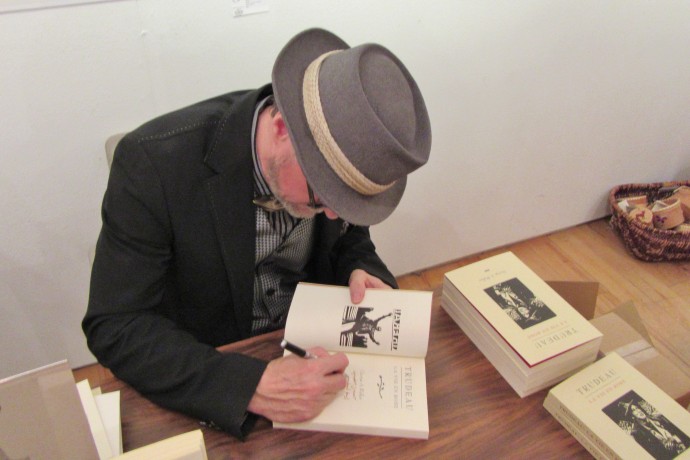 George signs a copy of the trade edition of Trudeau: Le Vie en Rose (The Porcupine’s Quill, Erin, Ontario, 2015). (Photo by Michelle Walker)
George signs a copy of the trade edition of Trudeau: Le Vie en Rose (The Porcupine’s Quill, Erin, Ontario, 2015). (Photo by Michelle Walker)
Even though you’re quite a master of producing wordless novels, were there any surprises or unexpected hurdles in the making of Trudeau? Please describe them?
With every new project there are challenges. I invited George Elliott Clarke to write a preface for the book. He was the Poet Laureate of Toronto and the author of a book of poetry on Trudeau titled Trudeau: Long March & Shining Path. He graciously agreed to provide some text. I had completed most of the engravings when I asked George to participate, and I told him I would welcome any suggestions. George had a lot of suggestions. I ended up making 10 new engravings based on his suggestions. It was an unexpected challenge but I think the work is better for it.
Were you able to meet your production schedule? If not, what slowed you down?
Many things can slow a job down. (See previous answer.) I had some challenges on the press involving some bad blocks, but these were easily fixed. One of the hurtles was the signing of the author sheets. I had no trouble getting Tom Smart and George Elliott Clarke signing their contributions—but—Mr. Justin Trudeau was in the middle of an election year. I had contacted his assistant, and she said to send the sheets to his office and he would sign them early the following week. Then our current Prime Minister Mr. Harper called the election early on the Sunday. This started the longest election campaign in recent Canadian history. It looked like Mr. Trudeau would not be able to sign them if he was campaigning. I wrote numerous frantic emails thinking my signing sheets would be lost. But he took a Monday off his busy schedule to sign the sheets for my book. Needless to say I hoped he would become our next Prime Minister.
What were your decisions behind how to bind the limited edition and how to present it in its box?
I followed the designs I used on the other limited edition wordless books. This one however was bound in full red leather. The box was covered in ¾ leather with canvass covered boards. I’m attaching some notes about the binding to this email.
Does Justin Trudeau’s being elected Canada’s prime minister after leading his party to a majority victory in the 19 Oct. 2015 federal election add in any way to your satisfaction with your book? If so, in what ways?
Yes, his signature in the limited edition makes the project an historical document. Not everyone can say they have their artwork signed by a prime minister! I felt very privileged to work with such fantastic people on this project.
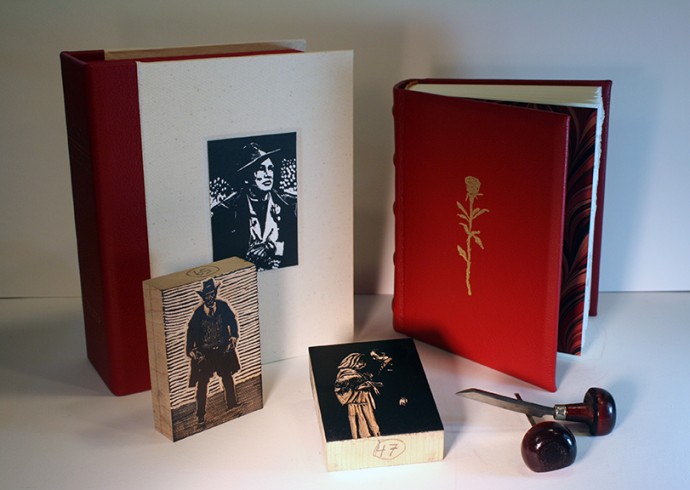 The finished limited edition: clamshell box, book, two blocks and two engraving tools.
The finished limited edition: clamshell box, book, two blocks and two engraving tools.
LINKS
On George Walker
Website: http://www.george-walker.com/
Wikipedia listing: https://en.wikipedia.org/wiki/George_Walker_%28printmaker%29
Book of Hours on YouTube: https://www.youtube.com/watch?v=GtZ1ZIr6EP0
Mysterious Death of Tom Thomson on YouTube: https://www.youtube.com/watch?v=6yH4MQlsUyg
Two YouTube videos with Walker talking or giving demonstrations: https://www.youtube.com/watch?v=nGOMhklq0QQ, and https://www.youtube.com/watch?v=RqRIhA4DQ7s
On Stefan Berg
Website: stefanberg.ca
Blog: http://lowerdawesstudio.blogspot.com/ and http://buddyboldenslastparade.blogspot.com/
YouTube of Buddy Bolden book launch: https://www.youtube.com/watch?v=hL8z51Wni5U
Trackback URL: https://www.scottponemone.com/walker-berg-updates-on-wordless-novelists/trackback/

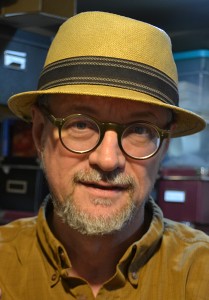
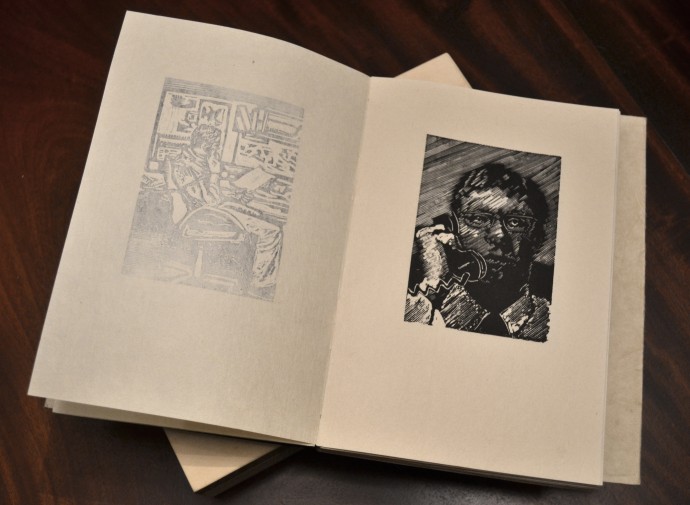
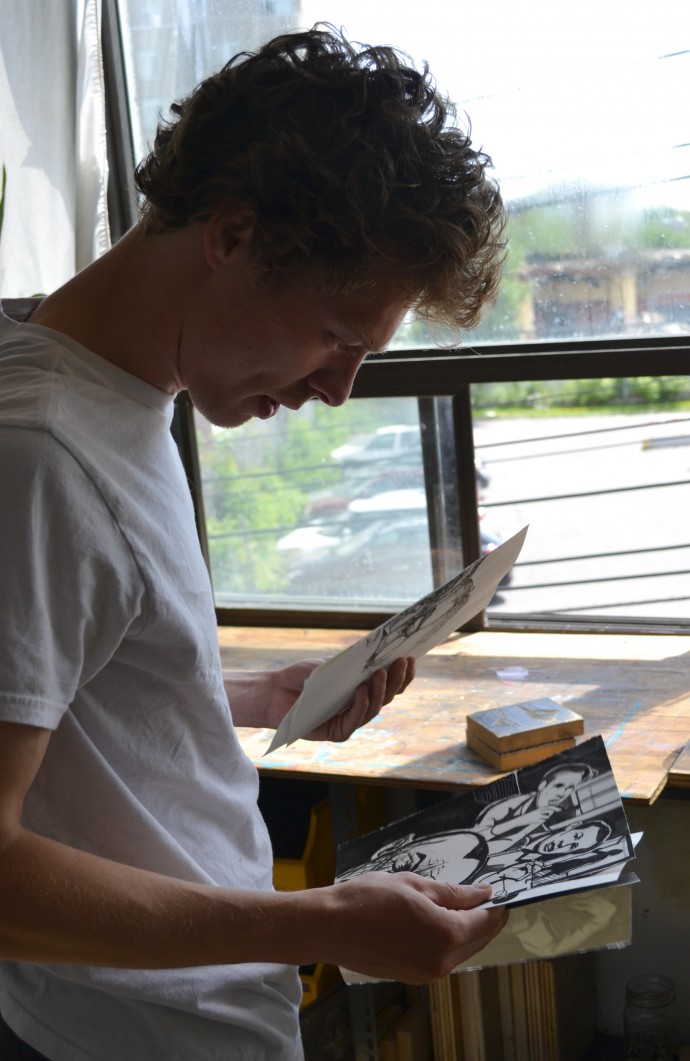
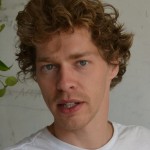

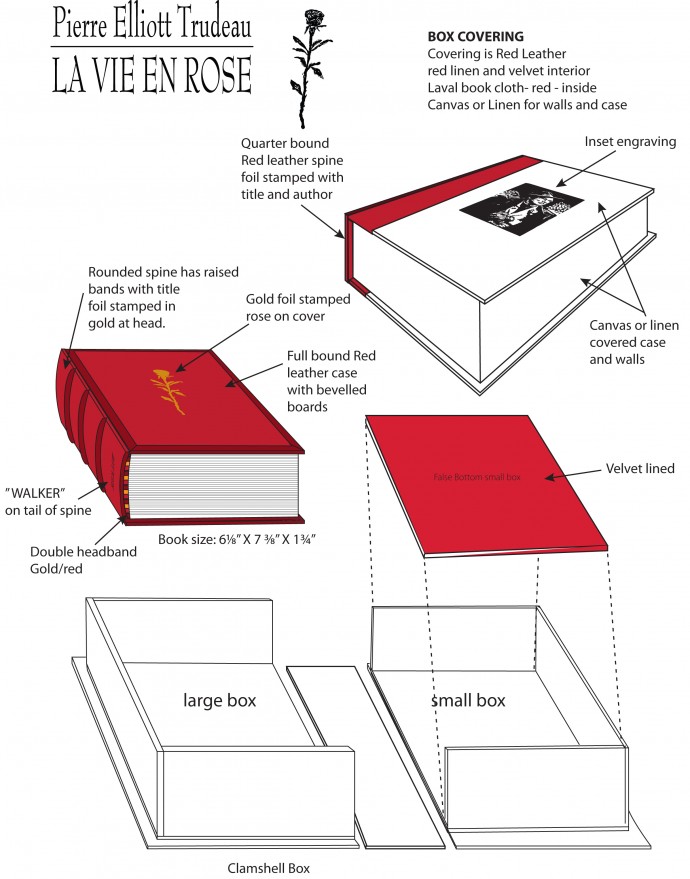










I thoroughly enjoyed reading this and learning about these amazing Canadian printmakers.
I especially like the reflective ones captioned, “Stefan holds up two early linoleum blocks for his Gould book.” Neat piece to read and look at,
Pingback: A Stefan Berg opportunity – Bill Andersen